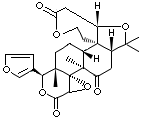PRODUCT IDENTIFICATION

TOXICITY
H.S. CODE
CLASSIFICATION
EXTRA NOTES
PHYSICAL AND CHEMICAL PROPERTIES
-0.72 (octanol-water)
REFRACTIVE INDEX
NFPA RATINGS
AUTOIGNITION
FLASH POINT
EXTERNAL LINKS & GENERAL DESCRIPTION
http://www.actahort.org/
Phytochemicals present in citrus fruits, such as triterpenoids and related
bitter compounds were of great concern to citrus industries during last decade
due to their unpleasant taste. These same compounds are gaining importance
during recent years, due to their proven benefits in prevention of cancer and
other chronic diseases. Both limonin and its glucoside isolated and purified
(purity of >99%) from Citrus aurantium L. seeds, were subjected to
proliferation inhibitory activity of cultured human colon adenocarcinoma cells
(SW480). Limonin has shown significant inhibitory activity at 25 μM
concentration, with inhibition of cancer cell proliferation by 42, 58 and 67%
after 24, 48 and 72 Hrs of incubation, respectively. However the activity was
not increased proportionately at 50 and 100 μM (67.8 and 68.9% after 72 hrs). On
the other hand, inhibitory effect of Limonin glucoside (LG) was significant at
6.25μM concentration (inhibition of 61% after 24 hrs). Inhibition of
proliferatation by 77% was observed in cells incubated with 100 μM LG for 72
Hrs. These results were also confirmed by content of lactate dehydrogenase (LDH)
leached by cells following treatment with compounds to medium indicating
cytotoxicity. Compounds treated at 100μM have shown DNA fragmentation of 200bp
indicating apoptosis induction to cytotoxicity. The results of the current study
indicates oxygenated terpenoids limonin and its glucoside may help in prevention
of colon cancer. Further investigations are necessary to understand the possible
mechanism of colon cancer prevention.
http://apjcn.nhri.org.tw/
Limonoids:
Citrus limonoids are responsible for the bitter taste in citrus
fruits. The most prevalent limonoids are limonin and nomilin. They
are present in the rutaceous plants that include lemon, lime, orange
and grapefruits. An important characteristic of this class of compound
is a substituted furan moiety. It has been determined by animal
studies that citrus limonoids and derivatives have certain biological
activities that may be used as chemopreventive agents for cancer.
Glutathione S-transferase (GST) is a major detoxifying enzyme system
that catalyses the conjugation of glutathione with electrophiles
that induce activated carcinogens. The glutathione conjugates are
usually less reactive and more water soluble, and hence, facilitate
excretion. An increase in GST activity caused by a substance is
therefore an elevation in the mechanism that protects against the
noxious effects of xenobiotics, including carcinogens. Many chemicals
that are GST enhancers have been found to inhibit chemically induced
carcinogenesis.12,13 The structures of the naturally occurring furanoids
that have been found to induce GST activity range from the simple
2-alkyl substituted compound 2-n-heptyl furan and the sulphur analogue
2-n-butyl thiophen, formed during the roasting of meat, to more
complex molecules such as kahweol and cafestol, isolated from green
coffee beans, and salannin, identified in the seed of the mythical
neem tree of India. The presence of the furan moiety appears to
be essential for enzyme induction. When the furan ring in cafestol
is saturated by hydrogenation, its activity as a GST inducer is
lost. In the case of limonin and nomilin, the triterpene structure
appears to play a part in determining the relative GST-inducing
activity of these compounds. The structure–activity relationships
of limonin and nomilin have been studied and discussed. The chemical
structures of limonin, nomilin and their glucoside derivatives are
shown in Fig.1.
http://pubs.acs.org/
SOME OBSERVATIONS ON THE STRUCTURE OF LIMONIN
APPEARANCE
white powder
PURITY
98.0% min (HPLC)
LOSS ON DRYING
0.5%